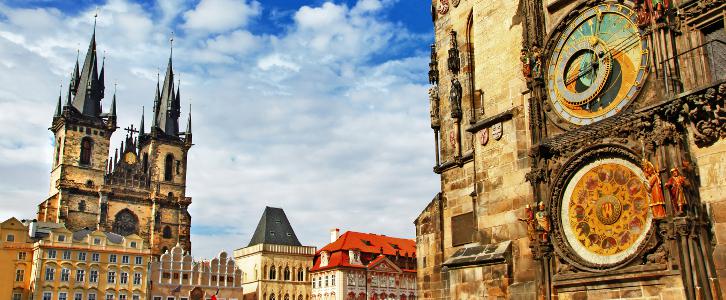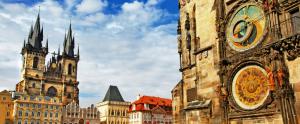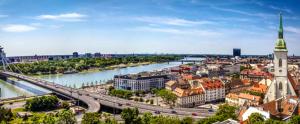You are here Home » Trips a-la-carte » Destinations » Czech Republic » Czech History
Czech Republic - Czech History

The Czech provinces have existed for more than 10 centuries. Due to their position in the center of the European continent, they have played important roles in all eras of history..
The Great Moravian Empire
The first genuine state structure on the territory of the Czech Republic was the Great Moravian Empire. This was located on the territory of Bohemia, Silesia, Moravia, Slovakia and the Danube Basin. In the west, it bordered on the powerful East Frankish Kingdom, from where Christianity spread to pagan Moravia.
The Přemyslid Dynasty
After the glorious period of the Great Moravian Empire, the center of the state moved westward to Bohemia. Power was concentrated here in the hands of the Přemyslids, who held onto it for more than 400 years until 1306, when it passed to the hands of the Luxemburgs.
The Luxemburgs & King Charles IV
After the death of Wenceslas III, the last king of the Přemyslid Dynasty , several kings supplanted each other as the head of state, but none could consolidate their position. A portion of the nobility and the abbots, who were dissatisfied with the reign of Jindřich Korutanský, concocted a coup. They deposed the king with the agreement of Emperor Henry VII of Luxemburg. The emperor consented to the marriage of his son John to Elizabeth (Eliška), the as- yet-unmarried sister of the last Přemyslid king. Thus, John of Luxemburg became the king of Bohemia between 1310 and 1346.
Hussitism And The Heritage of Jan Hus
The Czech lands were affected by an economic depression under the reign of Wenceslas IV, the son of Charles IV. Highwaymen and plague epidemics racked the country, while private wars raged. The Church, which was supposed to supervise the observance of God’s commandments, focused on attaining positions of power and accumulating property. Clergymen had long been performing jobs in the royal administration and instead of money they received a church office as settlement. Criticism of the Church grew stronger due to its deviation from its original principles, not just in Bohemia, but all over Europe.
The Habsburg Monarchy and Rudolph II
In this restless period, the Bohemian estates elected a new sovereign. Out of several candidates, they chose a member of a powerful family – the Habsburg Ferdinand I (1526–1564). Even he had to sign an electoral capitulation in which he undertook to uphold and respect the privileges of the estates. The Czech lands became part of a large combined state, which, besides them, principally comprised Austria and Hungary as well. With a few short-lived exceptions to Rudolph II, the sovereign’s court moved permanently to Vienna from Prague
The Thirty Years‘ War
Neither Matthias nor his brothers had any offspring. A family agreement designated Ferdinand of Styria as successor. He was only accepted as Bohemian king by the estates assemblies and was not elected. Although he pledged to observe the estates’ freedoms in his oath, including Rudolph’s Letter of Majesty, he had no intention of keeping his promise.
The Theresian Reforms
When the male line of the Habsburgs died out in 1740, Maria Theresa (1740–1780), the daughter of Charles VI, ascended the throne according to rules set by the Pragmatic Sanction. The recognition of the Sanction proved to be worthless though when the Prussian King Frederick II invaded Silesia, the richest land of the monarchy.
The Napoleonic Wars
In 1789, the French bourgeois revolution erupted in France, and a republic replaced the monarchy in that country. The Habsburgs could in no way reconcile themselves to the ideas that threatened their order. Besides reasons arising out of power politics, they were also related to the French king: Marie Antoinette, the wife of the last pre-Revolution French king, Louis XVI, was the daughter of Maria Theresa and the sister of two Habsburg emperors, Joseph II and Leopold II.
Ideas of The Czech National Revival
After a long period of oppression, the Czech nationhood had been preserved only in language and culture, especially in the countryside. There was still a long way to go toward emancipation from being a German-dependent state to a Czech national state.
The First Czechoslovak Republic
The son of Emperor Francis Joseph I, the crown prince Rudolph, committed suicide with his lover, so the succession passed to the Emperor’s nephew, Francis Ferdinand d’Este (also often referred to as Franz Ferdinand in English). Nevertheless, because of the dynastic irregularity of his marriage to Sophie von Chotkova, who was only a countess, he had to relinquish the succession rights of his children. In 1914, he left with his wife for an Austro-Hungarian Army exercise in Sarajevo
The Second World War
In negotiations with the Czechoslovak government on regulating the status of the German minority in Czechoslovakia, the Sudeten German Party proceeded according to Adolf Hitler’s instructions with the principal aim of not coming to an agreement and thereby increasing international tensions in regard to the status of Germans in the republic.
The Communist Regime
At the end of the Second World War, the Communist Party shared in the work of the Czechoslovak government for the first time, which signalized a clear move to the left after the experience of Nazism. Competition among political parties was restricted by a ban on re-establishing pre-war right-wing parties, which had been accused of collaborating with the Germans. All the permitted parties were grouped into a National Front and were all governing parties.
The Velvet Revolution & Its Consequences
On November 17, 1989, the regime led by the Communist Party harshly intervened against demonstrations organized by students on the occasion of the 50th anniversary of the closure of Czech schools by the Nazis. People came out on the streets to protest the brutality of the intervention and organized demonstrations and strikes.




